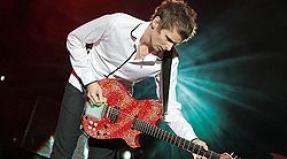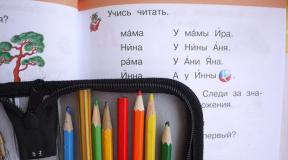Emotional awareness games and exercises. Exercises for children to develop the stability of emotions. Approximate options for a psychologist's conversation with children
Who am i? Do I know myself and what do I know about my friends? Do I always understand them, and they me? How to learn to understand yourself and other people? The training, the program of which is presented in the proposed book, will help the teenager find answers to these and other questions with the help of a psychologist. The publication reveals the features of psychological work with adolescents in the form of training aimed at self-knowledge, self-awareness, self-development of the teenager's personality. Various methods and practical techniques are presented, detailed development of lessons, the sequence of exercises and studies, as well as a methodology for discussing them with adolescents are given. The book is addressed to practical psychologists, teachers, teachers and students of psychological faculties, as well as specialists involved in the development of problems in practical child psychology.
Book:
Purpose: actualization of experience and knowledge related to the emotional sphere. Training in the ability to express your emotional state.
1. The ritual of greeting
2. Fingers
Children form a circle. Everyone clenches his hand into a fist, and at the command of the leader, everyone “throws out” their fingers. The group strives to ensure that all participants independently "throw out" the same number.
Participants are prohibited from negotiating, winking or trying to coordinate their actions in other "illegal" ways. The game continues until it reaches its goal.
Analysis.
It is possible to identify leaders (those who constantly "throw out" their number of fingers) and those who adjust to them. It is possible that a "negativist" will appear, stubbornly bending his line even after a certain agreement has already been reached between the other participants.
3. Emotions
- Emotions (from Latin emoveo - shock, excite) reflect the world around us in the form of direct experience of phenomena and situations, conditioned by the extent to which the latter satisfy our various needs.
Any new situation, information that contributes to the satisfaction of needs (or increases the likelihood of their satisfaction), evokes positive emotions, and information that reduces this probability inevitably evokes negative emotions. Therefore, in some cases, we choose such behavior that helps to strengthen, repeat joy, admiration, interest; in others, it is one that weakens or prevents fear, grief, anger. This is how emotions regulate our behavior.
We call the change in the general emotional background mood.
The highest form of development of emotions are feelings in relation to something, to someone associated, respectively, with the highest needs of a person. They are more complex and may even be contradictory. Feelings of love can include pride in a loved one and joy at their success, combined with pity for them, fear for their lives, and fear of losing their love. Sometimes people are surprised to find that they sometimes feel anger and hatred towards a loved one.
A person's emotional experience is enriched in the process of personal growth through empathy, which arises primarily in communication with other people. Emotions and feelings are the most important regulator of human communication.
4. "Names" of feelings
Each teenager writes down as many "names" of feelings as they can. The teenager who wrote down the largest number reads, while the psychologist writes down the words on the board. Then the number of matches between these words and the words of other children is counted.
The most famous (and therefore, presumably, the most used) emotions and emotional states are actualized, the difference between emotion and emotional state is explained.
Children put on the table the feelings that are typical for them and the feelings they are experiencing today.
The first column lists the "names" of the feelings. Then a cell is selected corresponding to the place where this feeling arises (there may be several places), crosses are put in the cells.
The first part of the table records the feelings that were most often experienced over the past six months, the second - the feelings that the participant experienced today.
You can use a 5-10-point scale to assess the intensity of the feeling.
Children are encouraged to find out how the people around them understand our feelings.
5. Mirror
One person shows some kind of grimace to a neighbor. That, in turn, "mimics" it as accurately as possible and passes on to his neighbor. "Grimace" is transmitted in a circle.
The exercise ends when the grimace returns to the first participant.
In the same way, a few more emotions are "transmitted".
Discussion.
What is the mechanism of feeling recognition?
What muscles are involved?
How do you feel when you see a facial expression of an emotion?
6. Pictogram
- Now I will distribute to some of you cards on which certain emotional states are indicated. Those who received the cards will read what is written on them, but so that other members of the group cannot see the inscription, and then they will depict this state in turn. We will all look and try to understand what state is depicted.
7. About the benefits and harms of emotions
AND. Discussion.
Are there any useless or 100% harmful feelings?
Are there feelings that do absolutely no harm?
B. Participants are divided into groups of 3-5 people, those who wish can work in pairs or alone, and fill out the table:
- I offer two senses for investigation: love and laziness. If the group wants to continue working, choose any third sense of their own accord.
8. The sculptor is clay
All children are divided into pairs. Each couple negotiates who will be the "sculptor" and who will be the "clay". Each "sculptor" must conceive some kind of feeling, write it down on a card, hide it in his pocket and not show it to anyone.
After the name of the sculpture is conceived, "the sculptor kneads the clay": he makes a "light massage" in order to sculpt the planned sculpture out of soft, pliable clay.
Then the sculptor puts the statue in the desired position, gives its face the desired expression and pronounces the magic formula: "The masterpiece is finished!" Only one thing is required of “sculpture”: to name oneself, that is, to indicate what feeling is expressed by a given pose and facial expressions. Having received an answer from the "sculpture", the "sculptor" takes out a card with a secret note. If the answer matches the intention, the "sculpture" will go to an exhibition of masterpieces.
Chairs serve as pedestals, and everyone who wants to guess the name of the sculpture can be admired spectators. If the audience also guesses the name, the author of the masterpiece is awarded the title of "Best Expression of Feelings".
Each participant should have the opportunity to test himself as a "sculptor" and as a "clay".
9. Homework
In front of the mirror, sculpt a sculpture out of yourself called "Cheerfulness, confidence, strength, cheerfulness." Remember the pose and facial expressions. Put on and wear this pose three times a day.
1. Box of happiness
This game develops not only EQ, but also imagination as well as memory. Create your own "box of happiness" in your head. Put everything in there that makes you feel happy. It is important that all five senses are involved: smell, sight, touch, hearing, taste.
For instance:
- taste - chocolate;
- sense of smell - the smell of plum blossoms;
- hearing - the sound of the sea;
- sight - the smile of a child;
- touch is the embrace of a loved one.
Invite your child to create their own box of happiness. Talk to him about your emotions and what triggers them.
2. The language of emotions
Action: Get into the habit of saying "I feel ... because ... I would like to ...". For example: I am upset because you broke my favorite vase. I wish you were neat. Now let's clean up together.
3. How I feel today
Every day the child chooses the emotion of the day. You can play at any age. Print out emoji pictures. You can take your favorite cartoon character. Have the child choose a picture and say “Today I felt joy / sadness / anger… when”.
This teaches a conscious perception of emotions and the ability to accept them and not be afraid.
4. Emotional album
Traveling is a great occasion and opportunity for new emotions. Try to capture the most interesting events with your child. Make your photos emotional. Here you are surprised, here you are scared, here you are happy, and so on.
You can create a special album where you add captions and short travel stories to your photos. The same pictures can be used for the game. Print, shuffle and come up with a story focusing only on the emotions in the photo.

5. Emotions in pictures
The rules are simple: you draw some kind of emotion, the child draws. Then you compare what happened. The composition and colors that the child chooses are important here. Then you can create your own gallery of emotions.
6. Emotional compass
An interesting game for the whole family, where everyone guesses emotions. The player receives eight cards (sadness, joy, anger, disgust, surprise, fear, interest, resentment). The list can be supplemented and changed. The main thing is that all participants have the same set of cards.
Rules: each guessing player comes up with a word, situation or concept that he associates with an emotion. Then he lays the card face down in a circle. The rest must guess what the emotion is.
In this game, children easily reveal their emotions. And parents can learn about the discrepancy between their perceptions and children's vision of the world. For example, the first day of school can make a child fearful or angry. And my mother will associate September 1st with joy.

7. I would be surprised if ...
The essence of the game is simple. You come up with funny situations that might surprise you. For example, I wonder if you wear my dress. I'd be surprised if Daddy comes home wearing a superhero costume. Etc. This is not only an opportunity to have fun, but also a great exercise in imagination and resourcefulness. Play also helps children understand what is expected and unexpected.
8. Six emotions on my face
Compete who is better at portraying all emotions: anger, joy, fear, disgust, print, interest, surprise, and so on. Can be done in front of a mirror or shown to each other. Fun, isn't it?
Natalia Bystrikova
Games for the development of emotions. Psycho-gymnastics methods for children
Emotions help the child adapt to a particular situation. Thanks to emotional development, the child will be able to regulate his behavior, avoiding those actions that he could commit under the influence of random circumstances and fleeting desires. Therefore, we consider it necessary not only to study, but also develop the emotional sphere of the preschooler, because emotion"Tell" others about the inner world of the child.
Currently, in our country, there is an increase in interest in the problem of the position of the child in society. As noted by A. I. Zakharov, “society begins to understand more and more that its foundations are laid in childhood and mental health is one of the most valuable acquisitions. "
Unfortunately, today game consoles, television, computers, mobile phones play a leading role in a child's life, therefore, this has a detrimental effect on development of the emotional sphere of preschoolers... In the visual activity of older preschoolers, the ideas become more stable, the possibilities of using the materials that the child chooses expand. He is able to take on the role "Artist", "Sculptor", "Masters", due, what motivates the choice of activity and material: "I want to paint a picture on an easel, I'll take a palette, brushes and paints".
Have children there is a selective attitude towards various types of visual activity. In drawing and sculpting from life, they convey the characteristic features of the subject.: shape outline, proportions, color. Hand movements gain confidence, become more coordinated. Hence the problem development of emotional spheres of preschoolers - relevant for consideration and study. So, is the process of visual activity an effective way of older preschool age? We can say that sustainable emotional a person's relationship to the phenomena of reality, reflecting their meaning in connection with his needs and motives, are called feelings. Part emotional sphere we include: emotion, feelings, self-esteem, anxiety. A child of the sixth year of life is a prisoner emotions. Children senior preschool age is distinguished by a very high emotionality, they still do not know how to manage their emotional states... But gradually they become more restrained and balanced.
Currently, there are many ways to work on development of the emotional sphere of childrensenior preschool age: art therapy (pictorial, fairy tale, musical); behavioral therapy (various types of trainings, psychogymnastics) ; game therapy; melotherapy, hypotherapy, isotherapy. Visual activity develops preschoolers have the ability to coordinate their actions, teaches them to be attentive to feelings and other people's emotions, that is, it promotes developing empathy... During development of the emotional sphere of children the older preschool age is changing. His view of the world and his attitude towards others are changing. The child's ability to be aware and control emotions increasebut by itself emotional preschooler's sphere is not is developing... It is necessary develop.
Psycho-gymnastics is a course of special classes (studies, exercises and games aimed at development and correction of various sides psyche of a child(both its cognitive and emotional and personal sphere). Main advantages psycho-gymnastics: the playful nature of the exercises (reliance on the leading activity children preschool age); preservation emotional well-being of children; reliance on imagination; the ability to use group forms of work.
Objectives psycho-gymnastics: reliance on natural mechanisms in child development; overcoming barriers in communication, understanding yourself and others; withdrawal mental stress and conservation emotional the well-being of the child; creating an opportunity for self-expression; development verbal language of feelings (naming emotion leads to emotional self-awareness of the child).
Tasks for development of the emotional sphere: randomly direct attention children on the experienced emotional sensations; distinguish and compare emotional sensations, determine their nature (pleasant, unpleasant, restless, surprising, scary, etc.); arbitrary and imitative "reproduce" or demonstrate emotion according to a given sample; catch, understand and distinguish the best emotional states; empathize (i.e., take the position of a communication partner and fully live, feel it emotional condition); respond with adequate feelings (i.e., in response to emotional the state of a friend to show such feelings that will bring satisfaction to the participants in the communication).
Characters psycho-gymnastics can be childrenas well as adults. Children just play, have fun, have interest, get to know the world around them, but at the same time learn the hard work of the ability to manage themselves and their emotions... Participation children the exercise must be voluntary. When to use psycho-gymnastics? First of all, such classes are shown to children with excessive fatigue, exhaustion, restlessness, quick-tempered, withdrawn, with neuroses, character disturbances, slight delays. mental development and other neuropsychiatric disorderslocated on the border of health and disease. It is equally important to use psycho-gymnastics in psycho-preventive work with practically healthy children in order to psychophysical discharge.
Structure of lessons on psycho-gymnastics... The initial stage is a conversation with children, an artistic word, a riddle, a bright, colorful toy, a surprise moment, and more. purpose: motivation children on the subject of the lesson or other form of work. The stage of living of actions - working out the basic movements, gymnastic exercises and more. purpose: achieving the result of teaching, educational and developmental tasks... Stage of organization emotional communication.purpose: training the general abilities of verbal and non-verbal exposure children on top of each other... The content of a child's communication with an adult or peer includes exercises such as exchanging the roles of communication partners, assessing their emotions and emotions of a partner... The stage of organizing controlled behavior. purpose: skill training children regulate your behavioral responses.
Methodical tasks: showing and replay typical situations with psychological difficulties; identifying and recognizing typical forms of adaptive and non-adaptive behavior; acquisition and consolidation of stereotypes of behavior and ways of resolving conflicts that are acceptable to the child; The final stage. purpose: consolidation of the content of the proposed material, as well as the positive effect that stimulates and streamlines mental and physical activity childrenbalancing them emotional state, improvement of well-being and mood. Exercise groups in psycho-gymnastics are aimed at development: movements; emotions; communication; behavior. Play (psycho-gymnastic) exercise content. It should contribute to mastering the skills of motor control and emotional spheres, that is, it should be thought out in such a way, to complete the following tasks: to give the child the opportunity to experience a variety of sensations (through imitative repetition of the movements and actions of the leading adult); train a child, direct and keep attention on their feelings, teach them to distinguish and compare them; train the child to change the nature of his movements, accompanied by various muscle sensations; train the child to change the nature of their movements, relying on the work of imagination and feelings.
In sequence psycho-gymnastic exercises, it is especially important to observe the alternation and comparison of movements that are opposite in nature, accompanied by alternating muscle tension and relaxation: tense and relaxed; sharp and smooth; frequent and slow; fractional and whole harmonious; barely noticeable movements and perfect freezing; body rotations and jumps; free movement in space and collisions with objects.
This alternation of movements harmonizes mental activity of the brain: ordered mental and the child's physical activity, the mood improves, the inertia of well-being is relieved. The process of regulating behavior includes plot and psychological exercises.At this stage, the following tasks are solved: showing - replay typical situations with psychological difficulties; highlighting and recognizing typical forms of adaptive and non-adaptive behavior; acquisition and consolidation of stereotypes of behavior and ways of resolving conflicts that are acceptable to the child; development skills of independent choice and building by children of suitable forms of reactions and actions within the framework of the situation.
Difficulty for the teacher is the transition from one image to another during the lesson, since the adult must be both in the image and lead the actions children... It takes skill here.
It is necessary to use a mirror for training. All work in a preschool educational institution should be aimed at preserving mental and physical health children... To measures to prevent fatigue in childrenpreschool age can be attributed: balanced daily routine, alternation of types of activities, their diversity, daily physical education, stay in the fresh air, sufficient physical activity. When planning classes, you need to consider:weekly performance dynamics: Monday - adaptation; Tuesday, Wednesday - the most stable and highest level of performance; from Thursday - decline in performance; daily dynamics of working capacity: high physiological activity of body systems is observed in the morning (from 8 to 11); decreased activity in the afternoon, lunchtime; restoration of working capacity in the period from 16 to 18 hours (with proper rest) and again its significant fall; health phases children in class: switching on, optimal performance, decreased performance; duration of active attention children,which depends on age: 3-4 years - 10 minutes, 4-5 years - 15 minutes, 6-7 years - 25 minutes. To prevent fatigue and maintain performance in childrenin the classroom it is necessary: create emotional attitude, maintain interest; consider that moderate emotion are an organizing factor, and strong ones are a disorganizing factor; maintain this level emotional stresswhere the activity children are effective; use various game situations, artistic words, elements of theatricalization, musical accompaniment; include elements psycho-gymnastics, exercises for relaxation; spend games and exercises for development general and fine motor skills, coordination of speech with movement; self-massage; exercises for development physiological respiration; articulation exercises, exercises for the prevention of visual fatigue (using special aids, visual reference points); exercises for development of attention parameters, memory, imagination.
Have children with undeveloped emotional and volitional the sphere is characterized by instability and weak purposefulness of activity, increased distractibility, impulsivity, hyperactivity.
Games for the development of the emotional sphere of preschoolers
Emotions play an important role in life childrenhelping to perceive and react to reality. Emotions a child is a message to others about his condition.
Emotions and feelingslike others mental processesgo through a difficult path throughout childhood development.
For young children emotions are the motives of behavior, which explains their impulsivity and instability. If babies are upset, hurt, angry or dissatisfied, they start screaming and crying inconsolably, banging their feet on the floor, and fall. This strategy allows them to completely release all physical stress that has arisen in the body.
In preschool age, the development of social forms of expression occurs emotions... Thanks to speech development of emotion preschoolers become conscious, they are an indicator of the general condition of the child, his mental and physical well-being.
The emotional system of children preschool age is still immature, so in unfavorable situations they may have inadequate emotional reactions, behavioral disorders that are a consequence of low self-esteem, feelings of resentment and anxiety. All of these feelings are normal human reactions, but it is difficult for children to express negative emotions in a proper way... Moreover, in children in preschool age there are problems in expression emotionsrelated to prohibitions by adults. This is a ban on loud laughter, a ban on tears (especially in boys, a ban on the expression of fear, aggression. A child of six already knows how to be restrained and can hide fear, aggression and tears, but, being for a long time in a state of resentment, anger, depression, child is experiencing emotional discomfort, voltage, and this is very harmful for mental and physical health. Experience emotional attitude to the worldacquired in preschool age, according to psychologists, is very durable and takes on the character of installation.
Games and exercisesaimed at getting to know human emotions, awareness of their emotionsas well as recognition emotional reactions of other children and development the ability to adequately express their emotion.
1. Game "Pictograms".
Children are offered a set of cards depicting various emotion.
On the table are pictograms of various emotions... Each child takes a card without showing it to others. After that, the children take turns trying to show emotiondrawn on cards. Spectators, they have to guess which emotion they are shown and explained how they determined what kind of emotion... The teacher makes sure that all children participate in the game.
This game will help you determine how well children are able to correctly express their emotions and"see" emotions of other people.
2. Exercise "Mirror".
The teacher passes a mirror in a circle and invites each child to look at himself, smile and say: "Hello, it's me!"
After completing the exercise, attention is drawn to the fact that when a person smiles, the corners of his mouth are directed upward, the cheeks can support the eyes so that they turn into small slits.
If the child finds it difficult to turn to himself the first time, do not insist on this. In this case, it is better to immediately transfer the mirror to the next member of the group. Such a child also requires special attention from adults.
This exercise can be diversified by inviting children to show sadness, surprise, fear, etc. Before doing this, you can show the children a pictogram depicting a given emotion, paying attention to the position of the eyebrows, eyes, mouth.
3. Game "I am glad when ..."
Educator: “Now I’ll call one of you by name, throw him a ball and ask, for example, so: "Sveta, tell us, please, when are you happy?".The child catches the ball and says: "I am glad when ....", then throws the ball to the next child and, calling him by name, in turn will ask: "(Child's name, tell us, please, when are you happy?"
This game can be diversified by inviting children to tell when they are upset, surprised, afraid. Such games can tell you about the child's inner world, about his relationship with both parents and peers.
4. Exercise "Music and emotion» .
After listening to a piece of music, children describe the mood of the music, what is she: cheerful sad, contented, angry, bold cowardly, festive everyday, sincere alienated, kind tired, warm cold, clear gloomy. This exercise helps not only developing an understanding of the transmission of emotional states, but also development of imaginative thinking.
5. Exercise "Ways to improve your mood".
It is proposed to discuss with the child how you can improve your own mood, try to come up with as many such ways as possible (smile at yourself in the mirror, try to laugh, remember something good, do a good deed to another, draw yourself a picture).
6. Game "Magic bag".
Before this game, the child discusses what his mood is now, what he feels, maybe he is offended by someone. Then invite the child to put all the negative emotion, anger, resentment, sadness. This bag, with all the bad things in it, is tightly tied. You can use one more "magic bag" from which the child can take those positive emotionthat he wants. The game is aimed at realizing one's own emotional states and release from negative emotions.
7. Game "Lotto of Sentiments"... To carry out this games sets of pictures are required, which depict animals with different facial expressions (for example, one set: funny fish, sad fish, angry fish, etc. :next set: squirrel is funny, squirrel is sad, squirrel is angry, etc.). The number of sets corresponds to the number children.
The presenter shows the children a schematic representation of one or another emotion... A task children - find in your set an animal with the same emotion.
8. Game "Name similar".
The host names the main emotion(or shows a schematic representation of it, children remember the words that mean this emotion.
This game activates vocabulary by using words for various emotion.
9. Exercise "My mood".
Children are encouraged to talk about their mood: can be compared with some color, animal, condition, weather, etc.
10. Game "Broken phone"... All participants gamesexcept for two, "Sleep"... The presenter silently shows the first participant any emotion with the help of facial expressions or pantomime. First participant, "Waking up" the second player passes what he saw emotion, as he understood it, also without words. Next, the second participant "Wakes up" third and gives him his version of what he saw. And so on until the last participant games.
After that, the presenter interviews all the participants. games, starting with the last and ending with the first, about what emotion, in their opinion, they were shown. This way you can find the link where the distortion occurred, or make sure that "telephone" was completely serviceable.
11. Game "What would have happened if."
An adult shows children a plot picture, the hero (s) which is missing (u) face (and)... Children are invited to name which emotion they think it is appropriate and why. After that, the adult invites the children to change the emotion on the hero's face... What would happen if he became cheerful (sad, angry, etc.?
Psycho-gymnastic exercises(sketches, the main goal of which is mastering the skills of managing your emotional sphere: development in children the ability to understand, be aware of their own and others emotion, express them correctly, fully experience.
1. New doll (study for the expression of joy).
The girl was presented with a new doll. She is happy, jumps merrily, whirls, plays with a doll.
2. Baba Yaga (study for the expression of anger).
Baba Yaga caught Alyonushka, told her to light the stove so that she could eat the girl later, and she fell asleep. I woke up, but Alyonushka did not - she ran away. Baba Yaga was angry that she was left without supper. Runs around the hut, stamping his feet, swinging his fists.
3. Focus (study for the expression of surprise).
The boy was very surprised: he saw how the magician put a cat in an empty suitcase and closed it, and when he opened the suitcase, the cat was not there. A dog jumped out of the suitcase.
4. Chanterelle overhears (study for expression of interest).
The chanterelle stands at the window of the hut in which the cat and the cock live, and overhears what they are talking about.
5. Salty tea (study for the expression of disgust).
The boy watched TV while eating. He poured tea into a cup and without looking, by mistake, instead of sugar, poured two tablespoons of salt. He interfered and took the first sip. What a disgusting taste!
6. New girl (study for the expression of contempt).
A new girl came to the group. She was in an elegant dress, holding a beautiful doll in her hands, and a large bow was tied on her head. She considered herself the most beautiful, and the rest children - unworthy of her attention. She looked down on everyone, her lips pursed in disdain.
7. About Tanya (sorrow is joy).
Our Tanya is crying out loud:
Dropped a ball into the river (grief).
"Hush, Tanechka, don't cry -
The ball will not sink in the river! "
8. Cinderella (study for the expression of sadness).
Cinderella returns from the ball very sad: she will not see the prince again, besides she has lost her slipper ...
9. Home alone (study for the expression of fear).
Mom-raccoon went to get food, baby-raccoon was left alone in the hole. It is dark all around, you can hear different rustles. The little raccoon is scared - what if someone attacks him, and his mother does not have time to come to the rescue?
Games and withdrawal exercises psycho-emotional stress... To form emotional stability of the child, it is important to teach him to control his body. The ability to relax allows you to eliminate anxiety, agitation, stiffness, restores strength, and increases the supply of energy.
1."Affectionate palms".
Children sit in a circle one after another. Stroke with the palms in front of the sitting child on the head, back, arms, lightly touching.
2. "Secrets".
Sew small bags of the same color. Pour various cereals into them, stuff it not tight. Suggest to children experiencing emotional discomfort, guess what is in the bags? Children crumple the bags in their hands, switch to other activities, thus leaving the negative state.
3. Game "In the meadow".
Educator: “Let's sit on the carpet, close our eyes and imagine that we are in a forest in a clearing. The sun is shining tenderly, the birds are singing, the trees rustle gently. Our bodies are relaxed. We are warm and comfortable. Consider the flowers around you. Which flower makes you feel happy? What colour is he?".
After a short pause, the teacher invites the children to open their eyes and tell them if they managed to imagine a clearing, the sun, the singing of birds, how they felt during this exercise. Did they see the flower? What was he like? Children are encouraged to draw what they saw.
4. Exercise "A wonderful dream of a kitten".
Children lie in a circle on their backs, arms and legs are freely extended, slightly divorced, eyes are closed.
Quiet, calm music turns on, against the background of which the presenter slowly says: “The little kitten was very tired, ran over, played enough and lay down to rest, curled up in a ball. He has a magical dream: blue sky, bright sun, clear water, silvery fish, family faces, friends, familiar animals, mom speaks affectionate words, a miracle is happening. A wonderful dream, but it's time to wake up. The kitten opens its eyes, stretches, smiles. " The host asks children about their dreamswhat did they see, hear, feel, did a miracle happen?
Conclusion
Everyone knows, but not everyone understands how important emotional activity for the formation of physical and mental healthhow much it is necessary to accustom children to live an active lifestyle. The problem of physical and mental health is very acute in our time.
According to the Research Institute of Hygiene and Health Protection, the number of children with pathology has doubled in recent years. But a full-fledged physical and mental child health is the basis for personality formation.
Municipal autonomous preschool educational institution
"Kindergarten No. 19 of general developmental type"
pechora
Card file of educational games and exercises for the development of the emotional sphere of children and stress relief
"I am glad, sad, surprised"
Compiled by:
music director
Krasova S.P.
Games card file
on the development of the emotional sphere of children
Emotions play an important role in children's lives, helping them perceive and react to reality. Feelings dominate all aspects of a preschooler's life, giving them a special color and expressiveness, therefore the emotions that he experiences are easily read on the face, in posture, gestures, in all behavior.
Entering kindergarten, a child finds himself in new, unusual conditions, surrounded by unfamiliar adults and children, with whom he has to establish relationships. In this situation, teachers and parents need to unite efforts to ensure the child's emotional comfort, develop the ability to communicate with peers.
Game "Kindergarten"
Two participants of the game are selected, the rest of the children are spectators. The participants are invited to act out the following situation - parents came to the kindergarten for the child. The child comes out to them with the expression of a certain emotional state. The audience must guess what state the participant in the game is representing, the parents must find out what happened to their child, and the child must tell the reason for his state.
Game "Artists"
Objective: to develop the ability and express various emotions on paper.
The participants in the game are presented with five cards depicting children with different emotional states and feelings. You need to choose one card and draw a story in which the chosen emotional state is the main plot. At the end of the work, an exhibition of drawings is held. Children guess who the hero of the plot is, and the author of the work tells the story depicted.
Game "The fourth odd"
Purpose: development of attention, perception, memory, recognition of various emotions.
The teacher presents the children with four pictograms of emotional states. The child must highlight one condition that does not fit the rest:
Joy, good nature, responsiveness, greed;
Sadness, resentment, guilt, joy;
Hard work, laziness, greed, envy;
Greed, anger, envy, responsiveness.
In another version of the game, the teacher reads the tasks without relying on picture material.
Sadness, grieving, having fun, grieving;
Rejoices, have fun, admire, get angry;
Joy, fun, happiness, anger;
Game "Whom - where"
Purpose: to develop the ability to recognize various emotions.
The teacher exhibits portraits of children with various expressions of emotional feelings and states. The child needs to choose those children who:
You can sit at the festive table;
You need to calm down, pick up;
Offended by the teacher;
The child must explain his choice, naming the signs by which he understood what mood each child depicted in the picture has.
The game "What would have happened if."
Objective: To develop the ability to recognize and express various emotions.
An adult shows children a plot picture, the hero (s) of which does not (s) face (s). Children are asked to name what emotion they think is appropriate and why. After that, the adult invites the children to change the emotion on the hero's face. What would happen if he became cheerful (sad, angry, etc.?
You can divide the children into groups according to the number of emotions and offer each group to act out the situation. For example, one group imagines and plays a situation in which the characters are angry, the other - a situation in which the characters laugh.
Game "What's up?"
Purpose: to teach children to recognize various emotional states, develop empathy.
The teacher exhibits portraits of children with various expressions of emotional states and feelings. The participants in the game take turns choosing any state, name it and come up with a reason why it arose: "Once I was very strong," because ... "For example," Once I was very offended because my friend ... "
"Little Raccoon"
Objective: To develop the ability to recognize and express various emotions.
One child is Little Raccoon, and the rest is his reflection (“The one who lives in the river.”) They sit freely on the carpet or stand in a line. The raccoon approaches the “river” and depicts different feelings (fear, interest, joy, and children accurately reflect them with the help of gestures and facial expressions. Then other children are alternately selected for the role of the Raccoon. The game ends with the song “From a smile, everyone will become warmer”).
Card file of games and exercises
Emotion anger, anger
Anger is one of the most important human emotions, and at the same time one of the most unpleasant.
An angry, aggressive child, a fighter and a bully is a big parental grief, a threat to the well-being of the children's collective, a "thunderstorm" of the yards, but at the same time an unhappy creature that no one understands, does not want to caress and regret. Aggressiveness in children is a sign of internal emotional distress, a bunch of negative experiences, one of the inadequate methods of psychological defense. Therefore, our task is to help the child get rid of the accumulated anger by constructive methods, that is, we must teach the preschooler available ways of expressing anger that do not harm others.
Game "Affectionate paws"
Purpose: relieving tension, muscle clamps, reducing aggressiveness, developing sensory perception.
Game progress: an adult picks up 6-7 small objects of various textures: a piece of fur, a tassel, a glass bottle, beads, cotton wool, etc. All this is laid out on the table. The child is invited to bare his arm to the elbow: the adult explains that the animal will walk along the arm and touch it with affectionate paws. It is necessary to guess with closed eyes which animal touched the hand - to guess the object. The touch should be stroking, pleasant.
Variant of the game: the "animal" will touch the cheek, knee, palm. You can change places with your child.
Exercise "Vile".
Purpose: to develop the ability to recognize different emotions using facial expressions and pantomime.
The children are asked to imagine that one of the children was "possessed" by anger and anger and turned him into an Angry One. Children stand in a circle, in the center of which stands the Grim Reaper. All together read a small poem:
Once upon a time there was a little boy (girl).
The little boy (girl) was angry.
The child playing the role of the Angry One must convey the appropriate emotional state with the help of facial expressions and pantomimics (eyebrows, pouting, waving his arms). When repeating the exercise, all children are encouraged to repeat the movements and facial expressions of an angry child.
Game "Magic bags"
Purpose: relieving mental stress in children.
Children are invited to put all negative emotions in the first magic bag: anger, anger, resentment, etc. You can even shout into the bag. After the children have spoken out, the bag is tied and hidden. Then the children are offered a second bag from which children can take those positive emotions that they want: joy, fun, kindness, etc.
Exercise "Finish a Sentence"
"Anger is when ..."
"I get angry when ..."
"Mom gets angry when ..."
"The teacher gets angry when ..."
“Now let's close our eyes and find a place on your body where anger lives in you. How does it feel? What color is it? There are glasses of water and paints in front of you, paint the water in the color of anger. Further, on the contour of a person, find a place, anger lives glee, and paint over this place with the color of anger. "
Exercise "Go away, angry, go away!"
Purpose: removal of aggressiveness.
The players lie on the carpet in a circle. There are pillows between them. Closing their eyes, they begin with all their strength to be feet on the floor, and hands on the pillows, with a loud cry "Go away, angry, go away!" The exercise lasts 3 minutes, then the participants, at the command of an adult, lie in the "star" pose, legs and arms wide apart, lie quietly, listening to calm music, for another 3 minutes.
Card file of games and exercises
Emotion of Surprise
Surprise is the most transient emotion. The surprise arises suddenly. If you have time to think about the event and speculate about whether or not what happened is surprising you, then you are not surprised. You cannot be surprised for a long time, unless the event that struck you opens up for you with its new unexpected facets. The wonder never stretches. When you stop experiencing surprise, it often disappears as quickly as it started.
Exercise "Finish the Sentence."
"Surprise is when ..."
"I wonder when ..."
"Mom is surprised when ..."
"The teacher is surprised when ..."
Exercise "Mirror".
Invite the children to look in the mirror, imagine that something fabulous is reflected there, and be surprised. To draw the attention of children to the fact that each person is surprised in his own way, but despite the difference, there is always something similar in the expressions of surprise. Question:
What is common in the way you portray surprise?
Game "Fantasy".
Children are invited to continue the start of amazing adventures:
An elephant came to us.
We ended up on another planet.
All the adults suddenly disappeared.
The magician changed all the signs on the shops at night.
Study Focus on expressing surprise
The boy was very surprised: he saw how the magician put a cat in an empty suitcase and closed it, and when he opened the suitcase, the cat was not there. A dog jumped out of the suitcase.
Study "The weather has changed".
Children are invited to imagine how suddenly, unexpectedly for everyone, the rain ended and the bright sun came out. And it happened so quickly that even the sparrows were surprised.
Question:
What happened to you when you imagined such an unexpected change in the weather?
Card file of games and exercises
Emotion Fear
Fear
This is one of the first emotions a newborn baby experiences; associated with a sense of danger. Already in the first months of life, the child begins to get scared, first by sharp sounds, then by unfamiliar surroundings, strangers. As a child grows, his fears often grow with him. The more the baby's knowledge expands, and the fantasy develops, the more he notices the dangers that lie in wait for each person. The line between normal, protective fear and pathological fear is often blurred, but in any case, fears prevent the child from living. They disturb him and can cause neurotic disorders, which manifest themselves in the form of tics, obsessive movements, enuresis, stuttering, poor sleep, irritability, aggressiveness, poor contact with others, and attention deficit. This is by no means a complete list of unpleasant consequences to which an unresolved child's fear leads.
Vulnerable, sensitive, and self-centered children are especially susceptible to fears. The most common fears among preschoolers are fear of the dark, nightmares, loneliness, fabulous hooligans, bandits, war, disasters, injections, pain, doctors.
Adults, and first of all, parents should help the child to overcome the fears that have arisen.
Exercise "Dress up a horror story."
Purpose: to give children the opportunity to work with the subject of fear.
The teacher prepares in advance black and white drawings of a scary character: Babu Yaga. He must "dress him" with plasticine. The child chooses the plasticine of the color he needs, tears off a small piece and smears it inside the horror story. When children "dress" a horror story, they tell the group about it, what this character loves and does not love, who is afraid of him, who is afraid of him?
Exercise "Draw the terrible."
Purpose: to help children express feelings in relation to the object of fear.
The presenter prepares in advance unfinished black and white drawings of a scary character: a skeleton ... He gives out to children and asks to finish drawing it. Then the children show pictures and tell stories about them.
Exercise "ABC of Moods".
Purpose: to teach children to find a constructive way out of the situation, to feel the emotional state of their character.
“Look at the pictures I brought you (cat, dog, frog). They all experience a sense of fear. Think and decide which of the characters each of you can show. At the same time, it must be said about what your hero is afraid of and what needs to be done to make his fear disappear.
Exercise "Boysek Competition".
Purpose: To provide children with the opportunity to actualize their fear of talking about it.
Children quickly pass the ball in a circle and complete the sentence: "Children are afraid ...". Those who cannot invent fear are eliminated from the game. You cannot repeat yourself. At the end, the winner of the "boysec" competition is determined.
Exercise "Fishermen and Fish".
Purpose: removal of psycho-muscular tension, fear of touch.
Two fish are selected. The rest of the participants stand in pairs facing each other in two lines, take each other by the hands - forming a "network". The presenter explains to the children that the small fish accidentally fell into the net and really wants to get out. The fish knows that it is dangerous, but freedom lies ahead. She should crawl on her stomach under clasped hands, which at the same time touch her on the back, lightly stroke her, tickle her. Crawling out of the net, the fish is waiting for its friend, crawling after her, they join hands together and become a net.
The game "Bee in the dark"
Purpose: correction of fear of darkness, confined space, height.
The course of the game: the bee flew from flower to flower (children's benches, highchairs, curbstones of different heights, soft modules are used). When the bee flew to the most beautiful flower with large petals, she ate nectar, drank dew and fell asleep inside the flower. A children's table or a high chair is used (a stool, under which a child climbs. Imperceptibly night fell, and the petals began to close (tables and chairs are covered with cloth). The bee woke up, opened her eyes and saw that it was dark all around. Then she remembered that she had remained inside the flower and decided to sleep until morning. The sun has risen, morning has come (the matter is removed, and the bee again began to have fun, flying from flower to flower. The game can be repeated, increasing the density of the tissue, thereby increasing the degree of darkness. The game can be carried out with one child or with a group children.
Exercise "Raise your fear."
Purpose: correction of the emotion of fear.
Children, together with the teacher, figure out how to raise fear in order to make the horror story kind, draw balloons on it, draw a smile, or make the horror story funny. If the child is afraid of the dark, draw a candle, etc.
Exercise "Trash can".
Purpose: relieving fears.
The presenter suggests tearing the pictures of fears into small pieces and throwing them into the trash can, thereby, getting rid of their fears.
Card file of games and exercises
Emotion Joy
Joy
The factor that reflects the emotional well-being of the child is the state of pleasure and joy. Joy is characterized as a pleasant, desired, positive feeling. When experiencing this emotion, the child does not experience any psychological or physical discomfort, he is carefree, he feels light and free, even his movements become easier, by themselves bringing him joy.
In childhood, the emotion of joy can be caused by quite certain types of stimulation. Its source for a child is daily communication with close adults, showing attention and care, in a playful interaction with parents and peers. The emotion of joy plays an important role in fostering feelings of affection and mutual trust between people.
Various exercises are used to get to know the emotion of joy.
Storytelling exercise .
Purpose: the development of expressive movements, the ability to understand the emotional state of another person and adequately express their own.
"Now I will tell you some stories, and we will try to act them out like real actors."
Story 1 "Good mood"
“Mom sent her son to the store:“ Please buy some cookies and sweets, ”she said,“ we'll have tea and go to the zoo. ” The boy took the money from his mother and skipped to the store. He was in a very good mood. "
Expressive movements: gait - brisk step, sometimes jumping, smile.
Story 2 "Umka".
“There was a friendly bear family: dad a bear, mom a bear and their little son, a bear cub Umka. Every evening mom and dad put Umka to bed. The bear hugged him tenderly and sang a lullaby with a smile, swaying to the beat of the melody. Dad stood next to me and smiled, and then, starting to sing along with mom a melody. "
Expressive movements: smile, smooth swaying.
Playing with a mirror.
“Today we will try to meet our smile in the mirror. Take a mirror, smile, find her in the mirror and finish one by one the sentence: "When I am happy, my smile is like ..."
Etude "Meeting with a friend"
The boy had a friend. But then summer came, and they had to leave. The boy stayed in the city, while his friend left with his parents to the south. It's boring in the city without a friend. A month has passed. One day a boy is walking down the street and suddenly sees his friend getting out of the trolleybus at a stop. How glad they were to each other!
Exercise "Draw ..."
Purpose: to consolidate the knowledge gained about the feeling of joy in children. "Let's play a game, I will name one of you by name, throw a ball to him and ask, for example," ... portray a joyful bunny. "
The one of you whom I will name, must catch the ball, depicting a bunny, says the following words: “I am a bunny. I am glad when ... "
"We train emotions"
Have your child frown- as:
Autumn cloud
Angry man
Evil sorceress.
smile like:
Cat in the sun
The sun itself
Like Pinocchio,
Like a sly fox
Like a joyous child
As if you saw a miracle.
posed like:
The kid who had their ice cream taken away
Two rams on the bridge
Like a man who got hit.
get scared like:
A child lost in the woods
The hare that saw the wolf
A kitten that a dog barks at.
get tired like:
Daddy after work
An ant who lifted a heavy load
rest like:
A tourist who has taken off a heavy backpack
A child who worked hard but helped his mother
Like a tired warrior after victory.
Exercises to expand emotional vocabulary
1. "Name similar"
Purpose: to activate vocabulary through words representing various emotions.
The facilitator names the main emotion (or shows a schematic representation of it, or acts it out himself), and the children remember the words that denote this emotion. You can divide the children into two teams. Representatives of each team in turn call synonyms. The team that last named the word wins.
2. Examination of pictures and paintings,where people, faces are depicted, we guess and name what mood this person has, we assume why it is.
Dictionary:funny, good, angry, bad, sad, gloomy, depressed.
3. We are trying to determine and name what expression of the eyes.
Dictionary:mocking, cunning, mischievous, reckless, sad, offended, angry, spiteful, insane, frightened, pitiful, pleading, begging, compassionate.
4.Podobrat words for the picture, which depicts the children having fun.
Dictionary:joy, fun, celebration, delight, jubilation.
5. We select words for a picture with a sad plot.
Dictionary:sadness, longing, sadness, despondency, grief, blues.
Emotional intelligence is among the top 10 competencies to master by 2020, according to a report from the World Economic Forum in Davos. How to develop it, says HR consultant and business coach Anna Khitrik.
By the end of the 20th century, researchers drew attention to the fact that it was not enough to have a high intelligence and be an expert in your field for a successful career. Something more is needed, related to the feelings and emotions of the person. This quality is called "emotional intelligence" (Emotional Intelligence).
According to scientific journalist Daniel Goleman, the concept of "emotional intelligence" includes 5 components.
1. Self-awareness - the ability of a person to correctly understand his emotions and motivation, to assess his weaknesses and strengths, to determine goals and life values.
2. Self-regulation - the ability to control your emotions and restrain impulses.
3. Motivation - the ability to strive for a goal for the very fact of its achievement.
4. Empathy - the ability to understand the emotions experienced by others, take into account the feelings of other people when making decisions, and also empathize with other people.
5. Social skills - the ability to build relationships with people and direct their behavior in the desired direction.
The high level of development of all components of EI helps us to build our careers more effectively and feel satisfaction from our work. Let's set aside 30 minutes for ourselves and organize a mini-training.
Learning to track your condition
A person achieves a goal only when he clearly sees where to go and understands what is happening around. Those who do not know their own emotional world go through life with their eyes closed.
According to Paul Ekman, an American psychologist and specialist in the study of emotions, we have 7 basic emotions: anger (anger), sadness (sadness), contempt, disgust, fear, surprise, joy. They are mixed into cocktails and form the basis of automatic reactions to what is happening. At the same time, several emotions (usually two) are leading in our life. And it's important to keep track of which ones.
Exercise 1.
To find out how much you understand your feelings, answer 3 questions.
1. What emotion am I experiencing now?
2. Is this emotion good for me right now?
3. How often throughout the day do I experience this emotion?
Only describe the emotions that you noted in yourself while reading these questions. This exercise will help kickstart the introspection process. Do it regularly in different situations, and over time you will get used to paying attention to your feelings.
Exercise 2. "Diary of emotions".
Throughout the day, write down all your emotions and the events that triggered them. The goal is to better understand yourself. For visualization, you can use felt-tip pens to indicate the color of emotions or emoticons. And then set yourself a challenge - to increase the number of funny emoticons. And remember that most events are neutral in themselves. And emotions are just our reaction to them.
Emotion | The event that caused it |
Managing emotions
Sometimes our emotions are like a tiger escaping from a circus: he is uncontrollable, so he can frighten and injure others (and he himself may suffer as a result).How do you learn to manage your reactions?
There are many techniques, for example - managing emotions "through the body." This is an interesting, and most importantly, an approach applicable in any conditions. The body and mind of a person are part of the same system, therefore, the physical and emotional state are closely interconnected.
Exercise 3.
1. Lower your head, droop your shoulders limply and, looking at the floor, say in a sad voice: "I am a successful person, everything works out for me ..."
2. Then raise your hands up, looking at the sky with your chin up, straighten your back and say in a confident voice: "I am a loser, everything goes awry, nothing works ..."
How did you feel? It turns out that the brain doesn't understand words! But facial expressions and gestures send signals to the subcortex of the brain (the ancient limbic system), and we begin to feel what the body is transmitting.
Now that you feel the difference, take the Leader Pose for at least a couple of minutes a day for two weeks. In the third week, you will see how the world around you has changed!
Of course, this is not enough for global changes.
If you want to control your inner world, you need:
Healthy food;
- physical activity (at least 30 minutes a day);
- breathing or other practices to concentrate and release tension.
As a "self-help" for every day, you can use a small exercise - it is appropriate to do it in the office or any other place.
Exercise 4.
Sit comfortably, catch your breath, and focus on your breathing. Breathe in calmly for 4 counts, hold your breath for 4 counts, exhale for 4 counts. Thus, increase the score up to 8 times. Breathe in until you feel that you have regained your emotional state.
We understand our inner motives
The heart of emotional intelligence is our own motivation. The rule is simple: if you do not know what you want yourself, you cannot motivate another (employee, child, loved one).
Motivation is the internal motors that force you to go forward and out of your comfort zone. Some are motivated to climb Everest, others - to knock their feet into the blood in pointe shoes in order to become a ballerina. And ineverything that is from the outside is a stimulus, the notorious "carrot", which has nothing to do with motivation.
A person cannot be motivated from the outside. You can only create the conditions in which the internal motors will work.
To realize your motives, you need to do some serious inner work. For some people, this becomes a lifelong journey.
Exercise 5.
How can you determine your motives? Ask yourself the question "Why?" And consecutively, 5 times. And answer it yourself. For example: "Why do I go to work?" Because this is my development. "Why is development important to me?" To prove to myself ... "Why do I need to prove to myself ...?" It is important for me to be worthy ... "Why is it important for me to be worthy ...?" I will be able to afford ... "Why is it important for me to afford ...?" To feel free and do what I love.
These simple 5 questions and answers provide insight into your deepest motives for action. By the way, e there is another question that explains a lot: "What would I do even without money?"
Develop empathy
Empathy is the ability to notice and correctly assess the emotions of others. Empathy (and its lack) has been experienced by everyone.
Probably, many got into such situations:
it seems to you that you are talking to another person in different languages;
someone deliberately (or unconsciously) demotivates the team;
you feel "alone in the crowd" when everyone is having fun;
you cannot understand a loved one and do not find words to convey your thought to him.
There are 3 levels of empathy:
1) understanding the point of view of another person;
2) determining the emotion that the interlocutor is experiencing;
3) selection of a reaction that is appropriate in this context.
Exercise 6.
How can you develop empathy? You will need a companion for this exercise. This can be a relative, friend, colleague, or just someone who is ready to help you and allocate 20 minutes of their time. Choose a comfortable location and a calm environment. Think over the topic of your conversation (do not discuss anything painful) and the sequence of the discussion.
5 minutes after the start of the conversation, mentally put yourself in the place of the interlocutor. Feel everything that may excite him now, what emotional impulses he is feeling. Keep your attention focused, memorize every feeling.
After 10 minutes, mentally move yourself to an observer position. This can be easier if you imagine looking at the conversation as if from the top corner of the room. Notice how your reactions to words have changed, how carefully you listen to the interlocutor. Many people say that this sharpens perception: if before that they seemed to be shown a movie of poor quality, now there are bright colors, focus and sharpness.
Repeat this exercise at least once a week. Empathy skill is being developed!
Here's a prime example of empathy.The Paralympics program included a 100-meter race. At the start of the treadmill were 9 participants with disabilities. A shot rang out, the race began. But when the participants ran about a third of the distance, one of them - almost a boy - stumbled and fell, making several somersaults. From pain and frustration, he began to cry. Hearing him crying, the other 8 participants stopped and ... came back. All! A girl with Down syndrome sat down next to the fallen guy, hugged him and asked: "Are you better now?" Then they all walked together to the finish line shoulder to shoulder. And the spectators at the stadium gave them a standing ovation ...
Social skills: finding the right words
Any communication is not what you want to say, but what kind of reaction you want to evoke.
The basic rules for successful communication are simple:
Arouse interest and trust in the first stage of contact;
confirm your theses (with statistical data, reliable information necessary for the interlocutor);
identify the needs of the interlocutor and offer solutions that are beneficial for him;
draw energy from novelty: meet new people, visit new places.
Exercise 7.
Suppose you have to introduce yourself to a very important forum tomorrow. You have exactly 31 seconds to perform. To prepare for your presentation, do the following:
Imagine the room where you will perform and the people who are in it;
Feel their emotions, understand what they want;
feel confident in yourself;
summarize your presentation in one sentence.
Let's summarize
So what is important for developing emotional intelligence?
Define and manage your emotions.
Understand your inner motors - motives.
Apply empathy skills in communication.
In the process of communication, understand the position and needs of the interlocutor.
Knowing what the people around you want, you can combine your goals, and then no one will lose!
Learn more about the role of emotional intelligence in work from the interview with Alina Nosenko


















